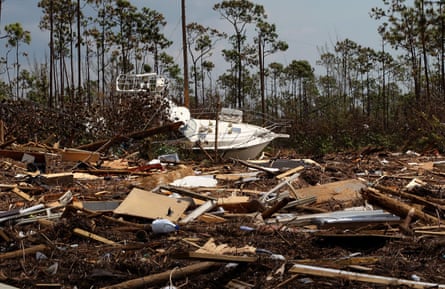Climate deniers like DeSantis hurt most vulnerable communities, scientists say
Misinformation spread by climate deniers such as Florida’s extremist Republican governor, Ron DeSantis, increases the “vulnerability” of communities in the path of severe weather events, scientists are warning.
The message comes on Saturday, the first day of what experts fear could be one of the most intense and dangerous Atlantic hurricane seasons on record, threatening a summer of natural disasters across the US.
Earlier this month, DeSantis signed a law erasing the words “climate change” from Florida statutes and in effect pledging the state’s future to burning fossil fuels, a significant contributory factor in global warming and an unprecedented “supersizing” of hurricanes’ destructive power.
“I can say I don’t believe in gravity, but if I step off a cliff I’m still going down,” Katharine Hayhoe, chief scientist of the Nature Conservancy, said during a webinar hosted by the group to discuss expectations for the six-month-long hurricane season.
“When we decide not to react to the information that science provides us, it’s a choice to increase our vulnerability rather than decrease it.”
Hayhoe also noted that “hurricanes are getting stronger and more dangerous, heavy rainfall is getting more frequent, home insurance is going up”, saying she’s “worried about what this means for my city”.
“We can say all of those things without mentioning the words ‘climate change’,” she continued.
“There are conversations that can still happen, and must still happen. It illustrates the importance of cities, community organizations, researchers, businesses, homeowners’ associations and insurance companies carrying that conversation and making the direct connection between what’s happening and why it matters to our homes, the places we live, our families and the people, places and things that matter most.”
Hayhoe said water in the Atlantic and Caribbean was already as hot as temperatures usually recorded at the peak of hurricane season in August and September. That does not bode well for a summer in which the National Oceanic and Atmospheric Administration (Noaa) expects up to 25 named tropical storms, including four to seven major hurricanes with winds at 111mph (179km/h) or higher.
“Heat-trapping gasses are building up in the atmosphere and wrapping an extra blanket around the planet, and nearly 90% of this extra heat is going to the ocean,” she said.
“We’ve been looking at record warm ocean temperatures for over a year now and they are what fuel these storms. When you think about that massive amount of heat and tropical storms plugged into the ocean as their power source, you can understand how we are really supercharging these events.”
The destructive power of storms has intensified so much in recent years that in February, a scientific study recommended adding a category 6 to the existing five-stage Saffir-Simpson scale to account for mega-hurricanes with sustained winds above 192mph. During the past decade, five storms would have met that criterion, the researchers said.
Hayhoe said other factors, including the amount of inland rainfall a storm might bring, also needed to be considered.
“There are indications that the storms are moving more slowly, which contributes to more rain because they’re sitting over you for longer,” she said. “And once they move over land, we are seeing that they’re lasting longer and weakening more slowly, so they’re reaching farther inland with greater impacts.”
Shenique Albury-Smith, deputy director of the conservancy’s Caribbean division, said the changing nature of extreme storm events should be seen as a call to action for governments, community groups and others to partner in a search for mitigation.
She highlighted as an example a mangrove-restoration project implemented in the Bahamas following Hurricane Dorian in 2019 that caused widespread devastation to the island nation.
“We’ve been utilizing data and technology to support communities in planning before a hurricane hits, and in the recovery phase after,” she said.

“How do you build a community’s skills and capabilities to prepare for any type of disaster more than hurricanes, for floods and landslides, as well as things like fires? It’s working with the community to teach them how to assess their vulnerabilities themselves so they can also work with experts who may be coming in from the Red Cross, or the Nature Conservancy, or government experts.”
Hayhoe said it was important that discussion about stronger storms focused on resilience, mitigation and global efforts to combat the climate emergency.
“Hurricanes provide a very strong fingerprint of how human activity, specifically emissions of heat-trapping gases, are supercharging our weather extremes and making them much more dangerous in a warming world,” she said.
“Disaster is a function of hazard and exposure: how many people and how much infrastructure, what things of value are exposed? Because if you have a category 5 hurricane that never makes landfall and it doesn’t hit any ships, there’s no exposure and it’s not a disaster.
“The third component is vulnerability. How prepared are we? How resilient are we? Vulnerability is a key indicator of whether a hazard with exposure turns into a disaster or not.
“So we need to talk about hurricanes in a way that directly addresses people’s vulnerability and empowers them to take action. We know we have solutions, many of them working with nature rather than against nature, to help us mitigate and adapt to this risk.”
Source: theguardian.com



